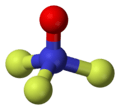Trifluoramine oxide
Trifluoramine oxide or Nitrogen oxide trifluoride (F3NO) is an inorganic molecule with strong fluorinating powers.
| |||
| Identifiers | |||
|---|---|---|---|
3D model (JSmol) |
|||
| ChemSpider | |||
PubChem CID |
|||
CompTox Dashboard (EPA) |
|||
| |||
| |||
| Properties | |||
| F3NO | |||
| Molar mass | 87.001 g·mol−1 | ||
| Melting point | −87.5 °C (−125.5 °F; 185.7 K) | ||
| Boiling point | −161 °C (−258 °F; 112 K) | ||
Except where otherwise noted, data are given for materials in their standard state (at 25 °C [77 °F], 100 kPa). | |||
| Infobox references | |||
Production
Trifluoramine oxide was first discovered in 1966 independently by two different groups. One way to produce it was by an electric discharge in a mixture of oxygen on nitrogen trifluoride. Another even less yielding method is by reacting noble metal fluorides (IrF6 or PtF6) with nitric oxide.[1] It is separated by distillation, and can be purified by treating it with potassium hydroxide solution which reacts with the other fluorine containing molecules produced.[1]
An alternate way to produce it is by burning nitric acid in fluorine, followed by rapid cooling.[2] Yet another way is the photochemical reaction of fluorine and nitrosyl fluoride: F2 + FNO → F3NO. This reaction can also happen with heat, but hot fluorine is hard to contain without a reaction with the container.[3] yet another production route is to thermally decompose nitrosyl hexafluoronickelate (NO)2NiF6 + ONF + ONF3.[4]
Properties
F3NO is a colourless gas at standard conditions. It has a critical temperature of 29.5° C where the density is 0.593 g/cm3. Critical pressure is about 64 atmospheres.[5]
Trifluoramine oxide has a Trouton's constant of 20.7.[5] Heat of vapourisation at the boiling point is 3.85 kcal/mol.[5]
The F3NO molecule has C3V symmetry, with all the N-F bonds being equivalent. The shape is almost a tetrahedron as N-O bond is similar to the N-F bonds in nature.[1] The nuclear magnetic resonance (NMR) spectrum of 19F has a triplet line around −363 ppm. JNF is 136 Hz.[1] The infra red spectrum N-O stretch at 1687 cm−1, N-F stretch at 743 cm−1, unsymmetrical N-F stretch 887 cm−1 ∠ONF bend 528 cm−1, wither other bands at 558, 528, 801, 929, 1055, 1410, 1622, 1772, 2435, and 3345 cm−1.[1] The dipole moment is 0.0390 D.[6]
The N-O bond has 75% double bond character. This differs from the amine oxides where the amine is much more basic and with a positive charge.[5] The N-O bond-length is 1.158 Å; the N–F bond-length is 1.431 Å ; the bond angles ∠FNF is 101°; and the three bond angles ∠ONF = 117.[7]
Trifluoramine oxide is toxic, killing rats at a concentration between 200 and 500 ppm.[5]
Reactions
On fluorinating other compounds nitrosyl fluoride (NOF) is formed.[8] Trifluoramine oxide does not react with water, glass or nickel, making it easier to handle.[1] The "adducts" formed with the pentafluorides, are actually hexafluoride salts containing the F2NO+ ion.[1]
| substrate | product[8] | comment |
|---|---|---|
| N2F4 | NF3 | |
| N2O4 | NO2F | |
| Cl2 | ClF | |
| SF4 | SF6 | |
| H2O | no reaction | |
| aqueous NaOH | NO3−,F− | slow |
| H2SO4 | HNO3,HF | via F2NO+ |
| SbF5 | SbF5•F3NO | |
| AsF5 | AsF5•F3NO | |
| PF5 | no reaction | |
| BF3 | BF3•F3NO | |
Trifluoramine oxide reacts slowly with mercury, producing mercury fluorides, and nitrogen oxides.[5] Trifluoramine oxide is fairly stable when heated to 300°C but slowly breaks up to fluorine and NO2F, NOF, NO2 and NO. The oxygen remains attached to the nitrogen during decomposition.[5]
References
- Fox, W. B.; MacKenzie, J. S.; Vanderkooi, N.; Sukornick, B.; Wamser, C. A.; Holmes, J. R.; Eibeck, R. E.; Stewart, B. B. (June 1966). "Trifluoramine Oxide". Journal of the American Chemical Society. 88 (11): 2604–2605. doi:10.1021/ja00963a051.
- Powell, P. (2013). The Chemistry of the Non-Metals. Springer Science & Business Media. p. 134. ISBN 9789401169042.
- Fox, W.B.; MacKenzie, J.S.; Vitek, R. (February 1970). "The chemistry of trifluoramine oxide. V. Synthesis of F3 no by photochemical fluorination of nitrosyl fluoride". Inorganic and Nuclear Chemistry Letters. 6 (2): 177–179. doi:10.1016/0020-1650(70)80336-1.
- Bartlett, Neil; Passmore, J.; Wells, E. J. (1966). "Nitrogen oxide trifluoride". Chemical Communications (London) (7): 213. doi:10.1039/C19660000213.
- Fox, W. B.; MacKenzie, J. S.; McCarthy, E. R.; Holmes, J. R.; Stahl, R. F.; Juurik, R. (October 1968). "Chemistry of trifluoramine oxide. I. Synthesis and characterization of trifluoramine". Inorganic Chemistry. 7 (10): 2064–2067. doi:10.1021/ic50068a022.
- Kirchhoff, William H.; Lide, David R. (July 1969). "Microwave Spectrum, Dipole Moment, and Quadrupole Coupling Constant of Trifluoramine Oxide". The Journal of Chemical Physics. 51 (1): 467–468. doi:10.1063/1.1671761.
- Plato, Vernon; Hartford, William D.; Hedberg, Kenneth (November 1970). "Electron‐Diffraction Investigation of the Molecular Structure of Trifluoramine Oxide, F3NO". The Journal of Chemical Physics. 53 (9): 3488–3494. doi:10.1063/1.1674522.
- Fox, William B.; Wamser, C. A.; Eibeck, R.; Huggins, D. K.; MacKenzie, James S.; Juurik, R. (June 1969). "Chemistry of trifluoroamine oxide. II. Reactions with inorganic substrates". Inorganic Chemistry. 8 (6): 1247–1249. doi:10.1021/ic50076a010.

